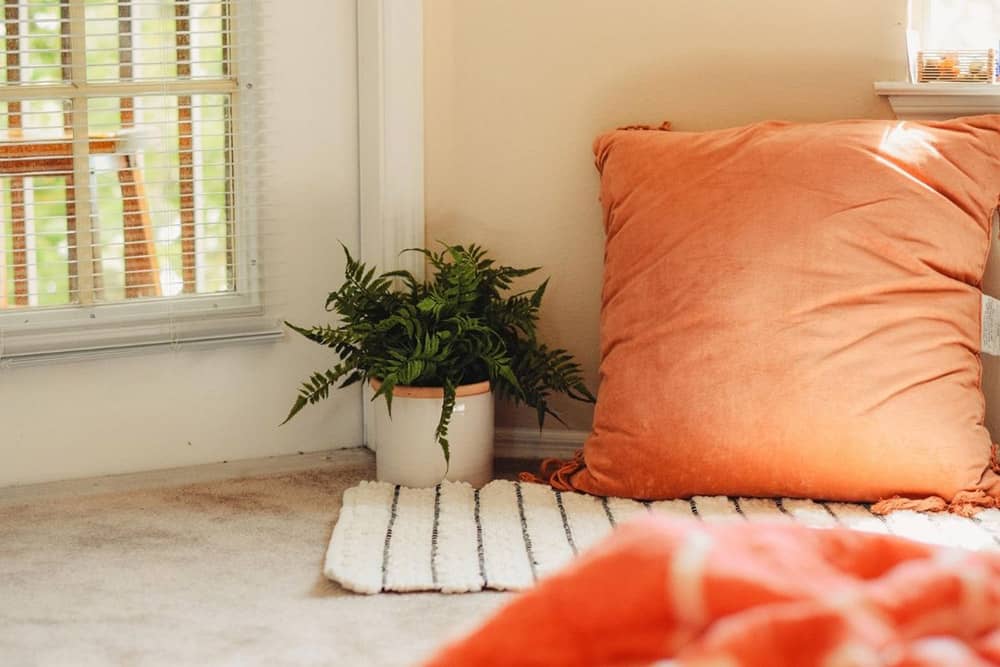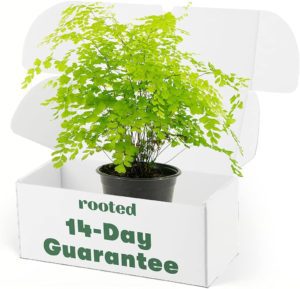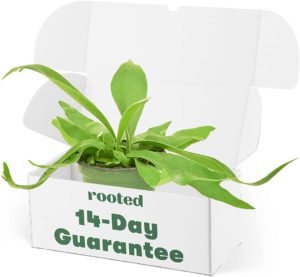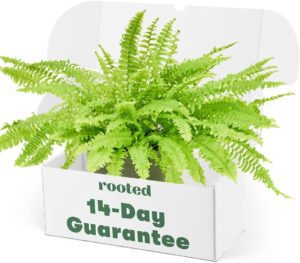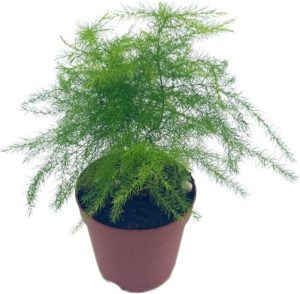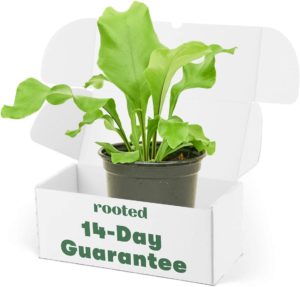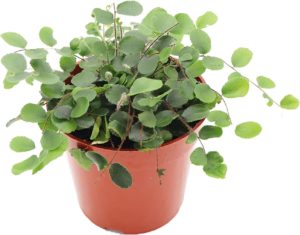During their evolutionary journey, outdoor ferns have adapted to the relatively low-light, humid, and dense vegetative conditions found in many rainforests, swampy, and damp areas found throughout the world.
These evolutionary traits make all types of ferns the perfect low-fuss, low-maintenance option for many a variety of indoor spaces. There are many ways to replicate the humid conditions ferns love right in your own home!
Couple these growing requirements with a fern’s beautiful, elegant, and delicate growth and you’ve got yourself the perfect houseplant.
Plus, if you want to bring a bit of greenery to your home or office, wish to add a layer of class to your home, or simply want to liven the feel or vibe of a living space, ferns really are a fantastic option.
So to help you find a few indoor ferns and variety that match the feel of your home and keep your indoor feeling outdoors, here are the most popular tree ferns and species that are commonly kept as indoor plants.
Types of ferns that make great indoor plants
Maidenhair Fern (Adiantum)
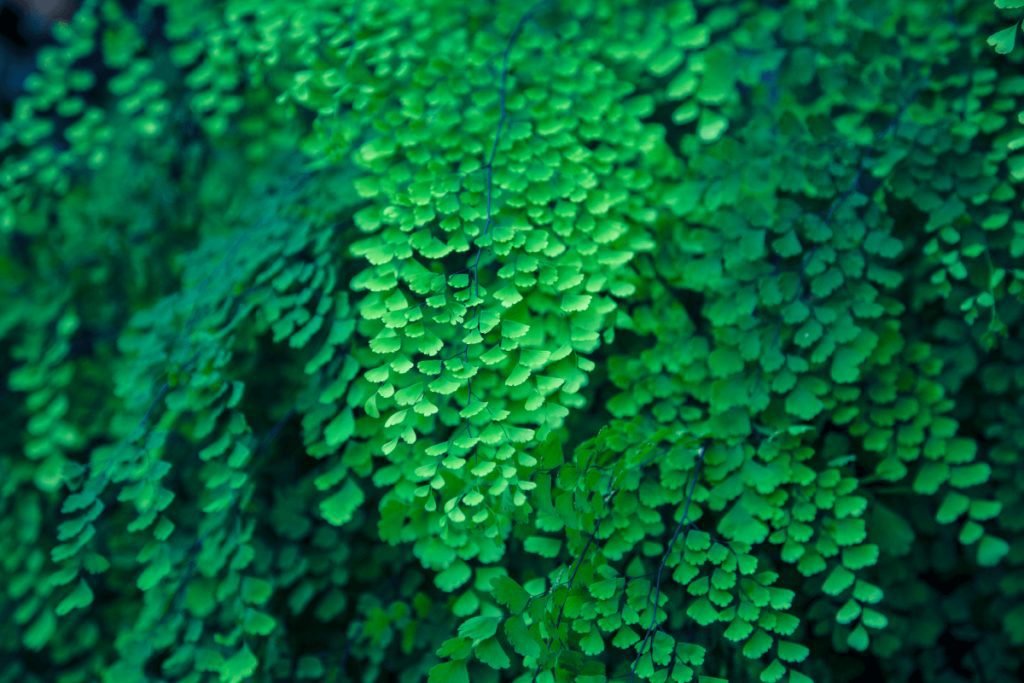
Origin: Africa, North America, New Zealand, Australia, Mexico, Central America, South America, Bangladesh, Burma, India, Nepal, Philippines, Thailand, China, Japan
The Adiantum genus, commonly known as the Maidenhair Fern, is the parent to an exhaustive list of over 250 different fern species many of which make awesome plant companions for the home. Maidenhair Ferns are highly prized for their distinctive appearances, luscious growth, beautiful colorations, and their elegantly shaped leaves.
Maidenhairs particularly enjoy potting soils that are high in humus, are relatively well-draining, and hold an adequate amount of moisture content.
Staghorn Fern (Platycerium)
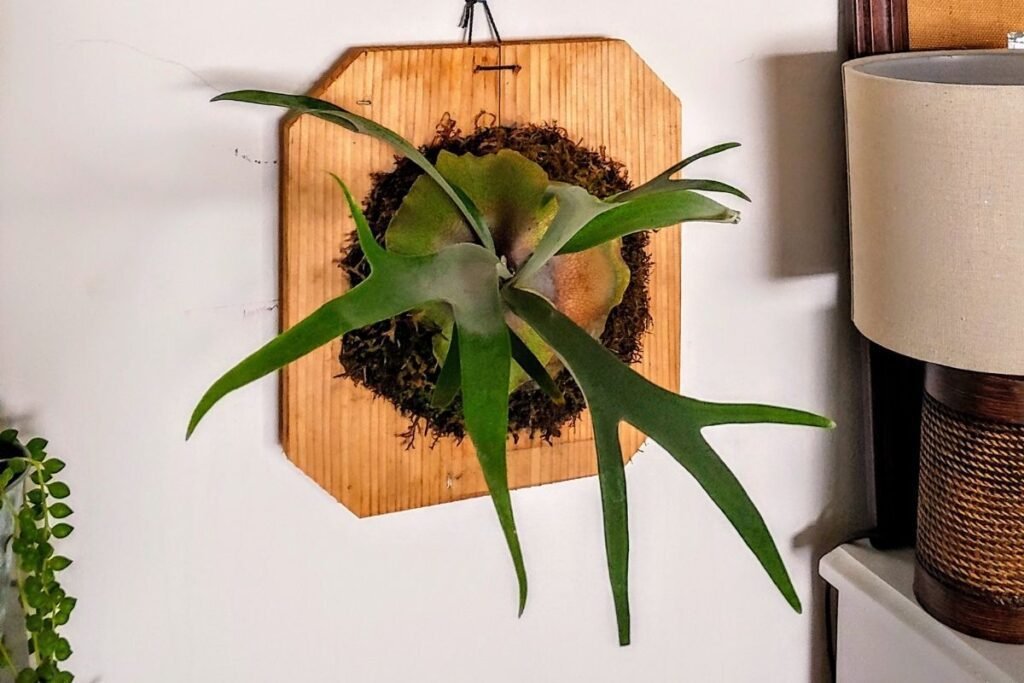
Origin: South America, Southeast Asia, Africa, Australia, and New Guinea
The genus Platycerium, commonly known as the Staghorn Fern, consists of a small list of just 18 species with all of them suitable to be kept as houseplants. If you happen to live in a tropical area and enjoy hiking the wet rainforests, you’ll likely have noticed Staghorn Ferns growing as epiphytes on large tree trunks.
For this reason, Staghorn Ferns are tropical ferns that are often mounted to mounting boards, wire baskets, or fern fiber and then kept in low-light, damp conditions like those found in the home, attached to a tree in tropical areas, or kept within greenhouses.
Boston Fern or Sword Fern (Nephrolepis)
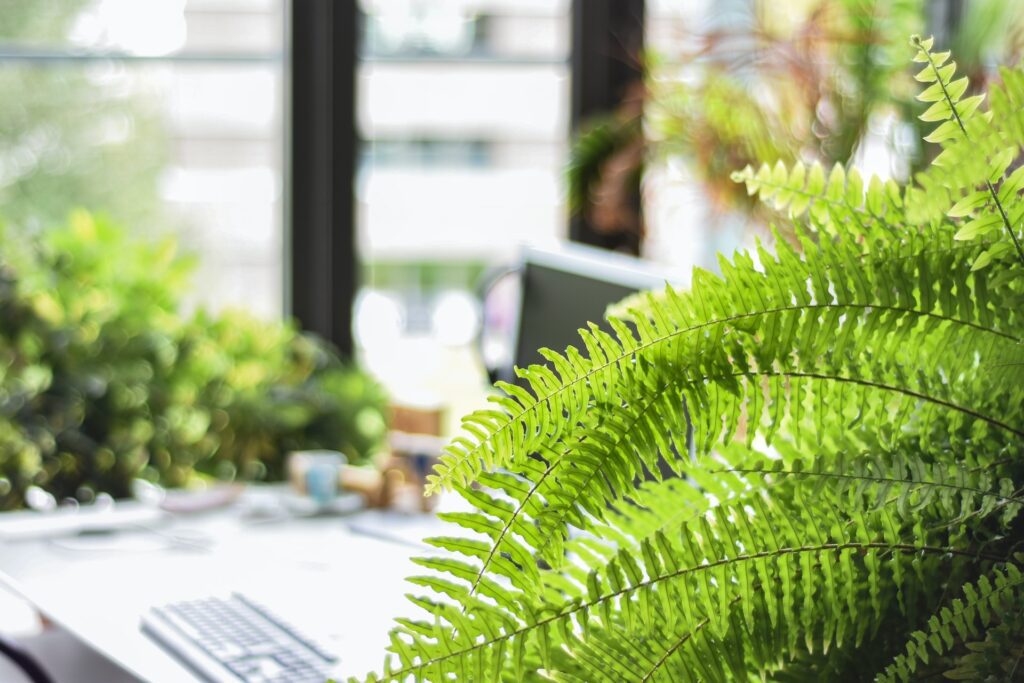
Origin: South America, Mexico, Central America, Florida, the West Indies, Polynesia, and Africa.
The Nephrolepis genus, commonly known as Boston Fern or Sword Fern, is comprised of a list of 30 different species. These ferns are native to the many moist, shady swamps and floodplains throughout the world where they grow as epiphytes on trees, rocks and other woody vegetation.
They were first introduced to the United States in the 1850s and slowly became a highly-priced houseplant.
The Boston Fern makes an excellent hanging basket specimen or can be allowed to trail along the floor, making it an excellent choice for corners of rooms where light levels are low. They are hardy and easy to grow and maintain, making it an excellent addition to any home or office environment.
Plus, the lush dark green of foliage of the Boston Fern making it a great way to add a little touch of nature in a number of locations throughout the home.
Asparagus Fern or Foxtail Fern (Asparagus)
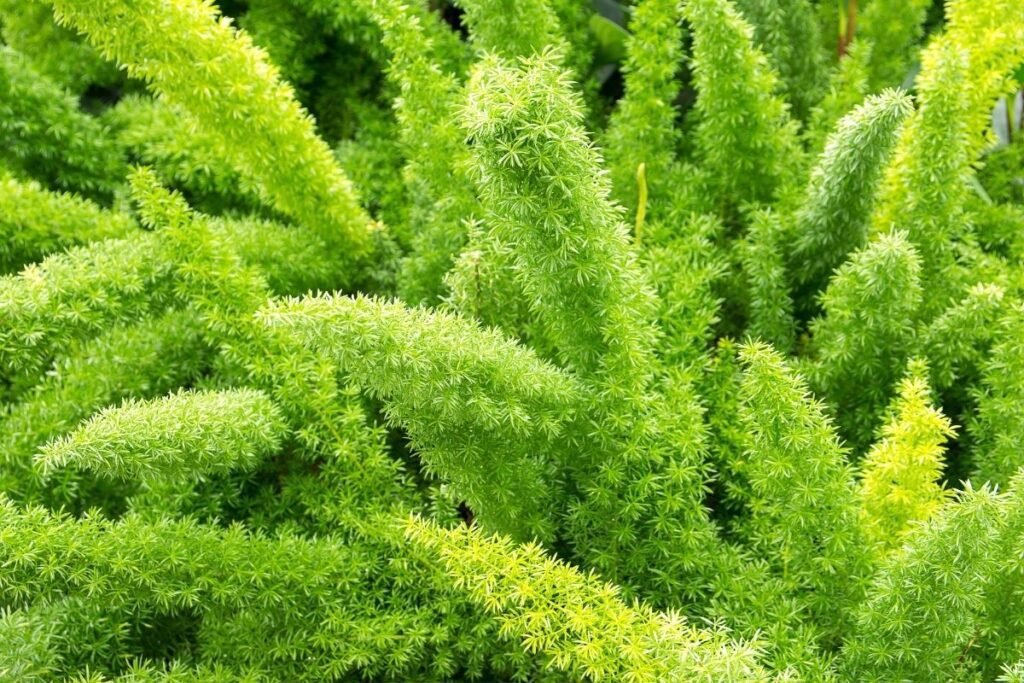
Origin: Cape Provinces and the Northern Provinces of South Africa
Asparagus fern, also commonly referred to as the Foxtail Fern, is a popular household plant that can be grown in hanging baskets or in decorative pots. It does really well indoors and is quite happy in low light conditions, making it a great choice for those dark, dim areas in the home that many other houseplants turn their noses up at.
The most attractive part of this plant is the foliage which resembles the shape of an asparagus spear. The leaves of the Asparagus Fern are a light green color with a velvety texture that grows in sparse, wide-spreading branches all growing from a single, tightly bunched root system.
Cinnamon Fern (Osmundastrum)
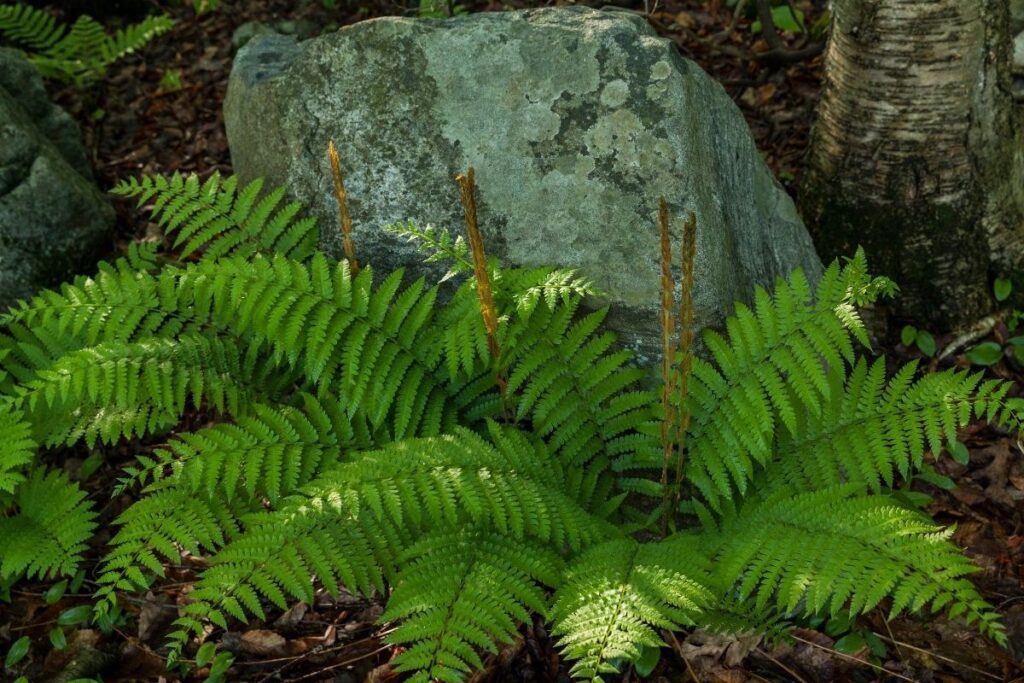
Origin: Cape Provinces and the Northern Provinces of South Africa
Cinnamon tree fern is a graceful, broadleaf evergreen fern with attractive divided leaves and delicate cinnamon-brown spores. It is a shade-loving plant that grows best in moist soil and also does well in containers.
Cinnamon ferns quite enjoy filtered sunlight and moist soil. They do not like it on the dry side, so be sure to potting soil evenly moist and refresh the potting media often.
Ostrich Fern or Fiddlehead Fern (Matteuccia)
Origin: Central and Northern Europe, Northern Asia, and North America
Ostrich Fern, also known as Fiddlehead Fern, is the only species in the genus MatteucciaIt. This very exotic-looking fern has strap-like leaves which are light green in color. The pale green fronds make a dramatic statement in any home or office environment. They are grown for their unusual appearance—the fantastic “fiddleheads” at the top of the plant make an admirable conversation piece and add interest to any décor. When ostrich ferns are mature, the fronds grow in a crown shape.
Bird’s Nest Fern (Asplenium)
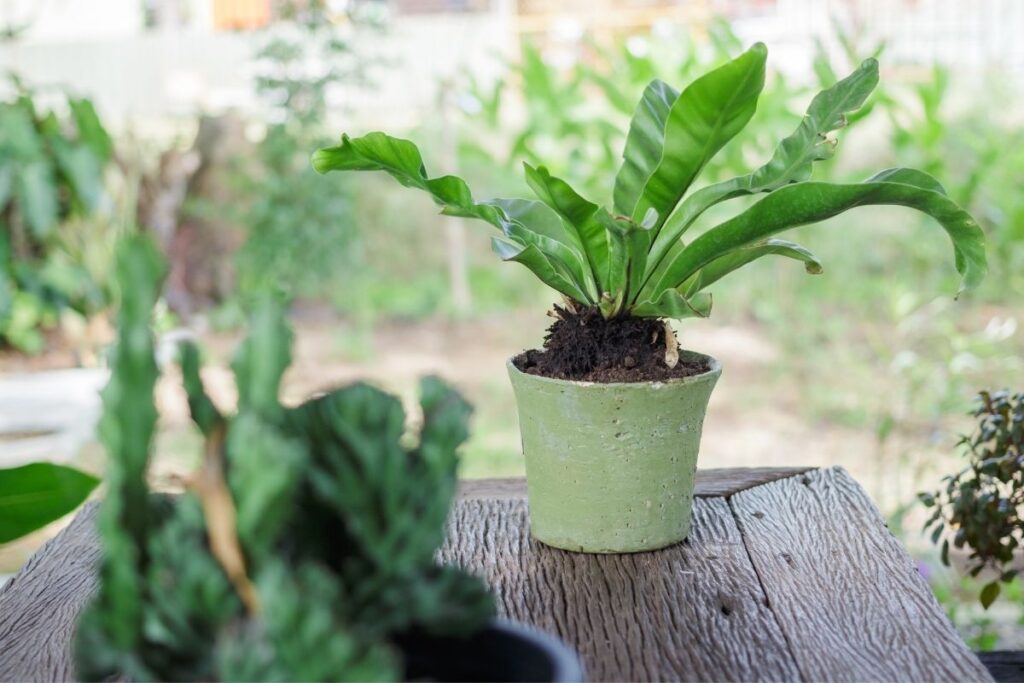
Origin: Europe and North America
Bird’s Nest Ferns or Bird’s nest spleenwort are probably one of the best types of ferns to grow as indoor houseplants. They are very low maintenance and look beautiful encircling a moss-filled pot. The fronds grow in rosettes and the ends of the leaves are outlined in black or dark red.
Bird’s Nest ferns need indirect sunlight, high humidity, and moist soil with good drainage. The plant will often grow new fronds at the base of older ones—If you prefer the look of whole plants with a few fronds on one long stem, trim any dead leaves earlier in the season.
Bracken Fern (Pteridium)
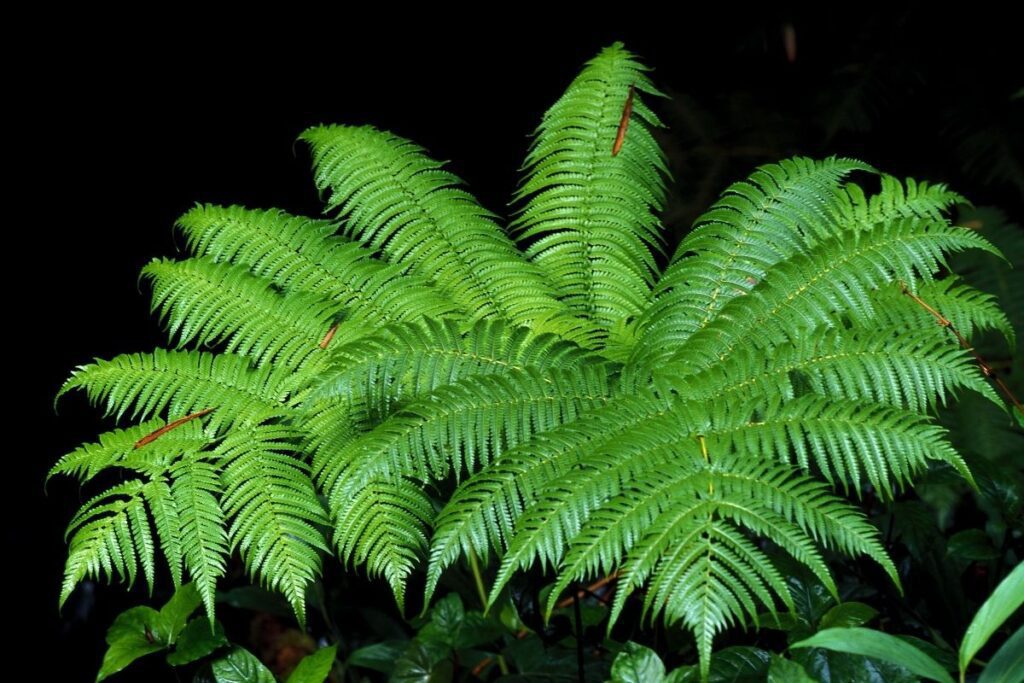
Origin: Occurring in most temperate and subtropical areas throughout much of the world.
Bracken ferns, commonly known as bracken, are resilient, long-lasting plants with big, highly divided leaves. They may be found all across the world except for Antarctica. Bracken ferns quite enjoy indoor conditions, often growing faster in homes than in outdoor settings.
They require moisture-filled soil with good drainage. And usually enjoy being placed in well-lit areas to encourage growth, but be sure to keep in mind direct sunlight may burn their sensitive fronds.
Hay Scented Fern (Dennstaedtia)
Origin: Eastern North America and eastern Asia
The Hay Scented fern is a deciduous fern that, when crushed, releases a scent of freshly cut hay. It spreads via rhizomes to create dense swaths of vegetation. Most notably, it is an excellent plant for homes that have to deal with poor air quality.
Hay Scented Fern thrives in shade and moist, organically rich soil. Although one established, it is an inherently flexible and hardy plant that can also survive in poor, rocky soil, and dry soil.
Commonly kept varieties and species as indoor plants:
- Dennstaedtia punctilobula
Button Fern (Pellaea)
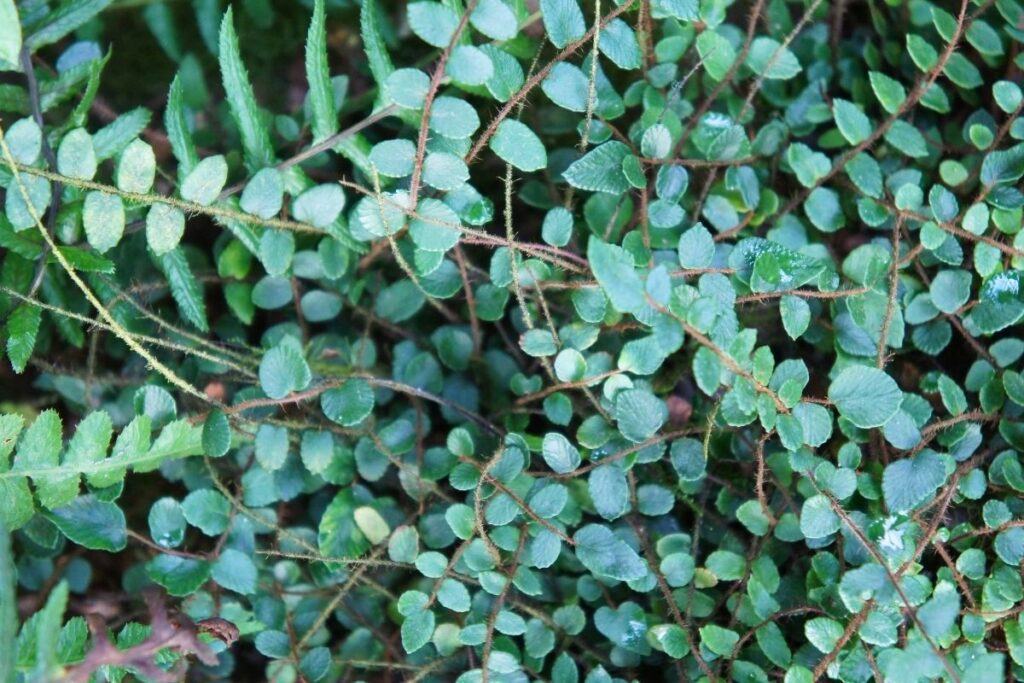
Origin: Southwestern USA, South America, Southern Africa, Eastern Australia, and New Zealand
Button Ferns are sturdy plants that need little care to grow. They prefer bright, indirect sunlight and moist soil. This hardy plant thrives in low light. For best results, place this tropical fern either on a plant stand among other tropical plants or in a hanging basket where the trailing of leathery, button-shaped leaflets cascades over the side.
Button Ferns require little maintenance. However, unlike most types of ferns, Button Ferns can endure fairly dry conditions and won’t tolerate wet soil in any respect. If your Button Ferns have brown tips, this is a sign that the humidity levels are too low. Increase the humidity by placing a tray filled with small stones just beneath the plant to increase the humidity immediately around its foliage.
Lemon Button Fern (Nephrolepis)
Origin: Australia and Asia
The Lemon Button Fern is a gorgeous plant that may be enjoyed by both novices and seasoned enthusiasts. It’s simple to maintain, and one of the more budget-friendly houseplants available.
Lemon Button Ferns may be grown in ordinary houseplant soil. They will do their best in a loose, peaty combination of soil if you want to get more specific. Your choice of planters and containers is virtually limitless. Any pot will do, a Lemon Button Fern will flourish as long as there is room for it to grow. It also releases a very faint lemony odor during the growing season.
Commonly kept varieties and species as indoor plants:
- Nephrolepis biserrata
- Nephrolepis cordifolia
- Nephrolepis falcata
- Nephrolepis obliterata
Sensitive Fern (Onoclea)
Origin: Eastern Asian and Eastern North America
The Sensitive Fern, also known as Bead Fern, is a tall deciduous perennial fern with a rough texture and medium to large growth. It flourishes in moist soil that is continuously wet, resulting in lush, apple-green frond leaves.
Onoclea sensibilis can be cultivated in a variety of conditions, with either partial shade or full shade being the most effective. It grows well in moist soil and may thrive in complete sunshine if kept wet. It spreads vegetatively through underground rhizomes making it super easy to propagate.
Commonly kept varieties and species as indoor plants:
- Onoclea sensibilis
Osmunda Fern or Royal Fern (Osmunda)
Origin: Europe, Africa, and Asia
The Royal fern, Osmunda regalis, is a magnificent, enormous fern that fails to disappoint. During the spring, large bright green fronds unfurl and seek out filtered sunlight. They turn golden brown in the fall before dying back.
This plant thrives in a variety of conditions but grows best in medium to wet soil in part to partial to full shade. It prefers moist, rich, humusy, acidic soils, but it will grow in less favorable circumstances. It also likes cool summer weather where it can withstand near direct sunlight as long as it is kept hydrated.
Commonly kept varieties and species as indoor plants:
- Osmunda regalis
Japanese Painted Fern (Athyrium niponicum var. pictum)
Origin: Japan, Korea, China and Taiwan
Japanese painted ferns are a deciduous fern native to Japan, Korea, China and Taiwan. It has a striking appearance with its metallic gray-green fronds that are accented with shades of purple, red, and silver. It prefers moist, well-draining soil and partial shade to full shade. This fern can grow up to 18 inches tall and wide, and is often used in shaded gardens, woodland settings, or as a container plant.
Australian Tree Fern (Cyathea cooperi)
Origin: eastern Australia
The Australian tree fern is a fast-growing evergreen fern that can reach heights of up to 30 feet. It is native to eastern Australia and is often grown as a specimen plant in gardens and parks. Its large fronds are light green and have a slightly arching habit. This fern prefers a moist, well-draining soil and partial shade to full shade.
Southern Maidenhair Fern (Adiantum capillus-veneris)
Origin: North America, South America, Europe, and Africa
The southern maidenhair fern is a delicate and graceful deciduous fern that is native to North America, South America, Europe, and Africa. It has lacy, fan-shaped fronds that are a light green color and can grow up to 18 inches tall and wide. This fern prefers moist, well-draining soil and partial shade to full shade. It is often used in rock gardens, woodland settings, or as a container plant.
Japanese Tassel Fern (Polystichum polyblepharum)
Origin: Japan, Korea, and eastern China
The Japanese Tassel Fern is a hardy evergreen fern that is native to Japan, Korea, and eastern China. It grows up to 2-3 feet tall and 1-2 feet wide and is ideal for shaded or partially shaded areas. It has dark green fronds that are glossy and leathery in texture. This hardy fern requires moderate watering and well-drained soil. It’s a great addition to any garden, especially if you want to create a Japanese-style garden.
Lady Fern (Athyrium filix-femina)
Origin: North America, Europe, and Asia
The lady fern is a deciduous fern that is native to North America, Europe, and Asia. It has lacy, light green fronds that can grow up to 3 feet tall and wide. This fern prefers moist, well-draining soil and partial shade to full shade. It is often used in woodland gardens or as a container plant.
Kangaroo Paw Fern (Microsorum diversifolium)
Origin: Australia and New Guinea
The kangaroo paw fern is a perennial fern native to Australia and New Guinea. It has dark green, leathery fronds that are shaped like kangaroo paws, with small finger-like projections at the tips. This fern prefers a moist, well-draining soil and partial shade to full shade. It can grow up to 3 feet tall and wide, and is often used in shaded gardens or as a container plant.
Crocodile Fern (Microsorum musifolium)
Origin: Southeast Asia, Polynesia, and Australia
The crocodile fern is a tropical evergreen fern native to Southeast Asia, Polynesia, and Australia. It has long, wavy fronds that are dark green with light green markings that resemble the scales of a crocodile. This fern prefers a moist, well-draining soil and partial shade to full shade. It can grow up to 2 feet tall and wide, and is often used in shaded gardens or as a container plant.
Rabbit’s Foot Fern (Davallia fejeensis)
Origin: Fiji
The Rabbit’s Foot Fern is an evergreen fern that is native to Fiji. It grows up to 1-2 feet tall and 1-2 feet wide and prefers partial to full shade. It has light green fronds that are delicate and lacy in texture, and fuzzy brown rhizomes that resemble a rabbit’s foot. The Rabbit’s Foot Fern requires moderate watering and well-drained soil. It’s a great addition to any garden, especially if you want to create a unique-looking landscape.
Japanese Holly Fern (Cyrtomium falcatum)
Origin: Japan, Korea, and eastern China
The Japanese Holly Fern is an evergreen fern that is native to Japan, Korea, and eastern China. It grows up to 2-3 feet tall and 1-2 feet wide and prefers partial to full shade. It has dark green fronds that are glossy and leathery in texture, and resemble the leaves of a holly plant. The Japanese Holly Fern requires moderate watering and well-drained soil. It’s a great addition to any garden, especially if you want to create a traditional Japanese-style garden.
Fern care tips
Indoor ferns are a popular choice for houseplants because of their lush foliage and low maintenance needs. However, not all ferns are created equal, and different types of ferns require different care. Here are some tips for growing healthy ferns indoors:
- Choose the right type of fern: There are many different fern species, each with their own unique requirements. If you’re planning to grow ferns indoors, look for tropical ferns like maidenhair ferns or boston ferns. These types of ferns prefer warm, humid environments and can tolerate low light conditions. I also recommend going with evergreen ferns since they’ll have beautiful green fronds all year long.
- Provide the right amount of light: Ferns generally prefer indirect light, as direct sunlight can scorch their delicate leaves. Place your ferns in a bright spot, but avoid exposing them to direct sunlight. If you notice your fern’s leaves turning yellow or brown, it may be getting too much light.
- Use the right growing medium: Ferns prefer a growing medium that is rich in organic matter and holds moisture well. A mix of peat moss and perlite or vermiculite is a good choice for ferns. Make sure the potting mix is well-draining, as ferns don’t like to sit in water.
- Water regularly: Ferns need consistent moisture to thrive, but they don’t like to be overwatered. Water your ferns when the top inch of soil feels dry to the touch, but don’t let the soil dry out completely. Avoid getting water on the leaves, as this can encourage fungal growth.
- Consider hanging baskets: Ferns are a great choice for hanging baskets, as they can trail down and create a lush, green look. Be sure to choose a basket with good drainage and use a light potting mix to avoid weighing down the basket.
- Consider tree trunks: Some ferns, like staghorn ferns, can be mounted on tree trunks or other objects for a unique display. If you choose to mount your fern, be sure to keep the growing medium moist and mist the leaves regularly to provide the necessary humidity.
Final thoughts
Growing indoor and outdoor ferns is a rewarding experience, as long as you find a fern species that works for you and your climate!

